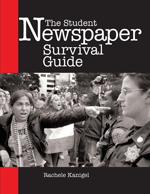Questions abound -- should you identify an openly gay source even if the person's sexual identity has nothing to do with the story? What should you do if rumors surface that a prominent campus figure -- such as a college president or a football coach -- is gay? Is it OK to call someone a "practicing homosexual"? Which pronoun should you use for a transgender person? (See answers below.)
Fortunately there are resources to help journalists write fairly and sensitively about GLBT people and issues.
Among them:
- National Gay and Lesbian Journalists Association -- Founded in 1990, NLGJA is an organization of journalists, media professionals, educators and students that works within the news industry to foster fair and accurate coverage of LGBT issues. Student membership is only $25 per year. The organization's Web site is chock full of useful resources. NLGJA sponsors an annual Excellence in Student Journalism Award and also sponsors scholarships and internships for students.
- The Leroy F. Aarons Journalism Education Program -- Named for the late founder of NLGJA, the Leroy F. Aarons Journalism Education Program provides resources for educators and opportunities for students.
- NGLJA stylebook supplement -- This stylebook supplement answers reporters' and copy editors' questions about GLBT terminology.
- Coverage Tips by Leroy F. Aaronson, Poynter -- The founder of the NLGJA lays out suggestions for covering gay and lesbian issues.
- Glad Media Reference Guide -- The Gay & Lesbian Alliance Against Defamation (GLAAD) is dedicated to promoting and ensuring fair, accurate and inclusive representation of people and events in the media as a means of eliminating homophobia and discrimination based on gender identity and sexual orientation. The organization's Web site is stocked with useful resources.
And the answers to the questions above:
1) There's no reason to identify a source as gay if the person's sexual identity has nothing to do with the story. Use your sources as a guidepost -- if he or she doesn't bring it up, you shouldn't either. If the person does raise the issue in some way, ask yourself whether it's really relevant to the story.
2) The practice of "outing" prominent people remains controversial. Some journalists think it's bad form. Others like former NLGJA President Eric Hegedus, who published this op-ed column in the San Francisco Chronicle last year, consider not outing prominent people "a professional sin of omission – the failure to get all the facts by shying away from asking a newsmaker his or her sexual orientation." One rule of thumb is to ask whether the person's sexual orientation is relevant to their position and whether they are prominent enough to have their personal life exposed.
3) Don't use the term "practicing" homosexual. If a person's behavior is relevant, use the phrase “sexually active” as a modifier.
4) The term transgender "can include preoperative, postoperative or nonoperative transsexuals; female and male cross-dressers; drag queens or kings; female or male impersonators; and intersex individuals," according to the Stylebook Supplement on LGBT Terminology produced by the National Lesbian and Gay Journalists Association. "When writing about a transgender person, use the name and personal pronouns that are consistent with the way the individual lives publicly."













